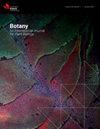真菌内生菌对加拿大纽芬兰地区濒危特有物种龙氏布拉亚(Braya longii)和费尔纳德布拉亚(Braya fernaldii)健康和恢复的影响
IF 1.3
4区 生物学
Q3 PLANT SCIENCES
引用次数: 0
摘要
Long 's (Braya longii)和Fernald 's (B. fernaldii) Braya是加拿大纽芬兰大北半岛特有的。由于栖息地丧失和退化,以及真菌感染和昆虫食草的持续威胁,这些草本多年生植物濒临灭绝。虽然正在实施恢复计划,但致病真菌的身份及其起源在很大程度上仍然未知。这项研究是为了描述相关的真菌群落和感染症状。对三个群体的植物组织进行了5年的取样,主要通过ITS-rDNA区域的核苷酸序列分析鉴定出326株真菌。分离株共36个分类群,其中检出1次的16个,检出3次及以下的5个。相比之下,在多个地点、采样间隔和年份中检测到12个分类群。其中包括两种Alternaria, Boeremia exigua, Didymellaceae的近缘种,Botrytis cinerea, Fusarium sp., Colletotrichum sp., Stagonosporopsis sp., Pleospora sp.和Truncatella angustata。一些常见分类群表现出季节变化趋势。分离的真菌包括已知的芸苔科病原体。本研究的植物经常表现出真菌感染和虫食的症状。这些发现提高了我们对布拉亚内生菌群落的认识,并将为这些濒危物种的恢复工作提供信息。本文章由计算机程序翻译,如有差异,请以英文原文为准。
Fungal endophytes affecting the health and recovery of Long’s Braya (Braya longii) and Fernald’s Braya (Braya fernaldii), endangered endemic species of Newfoundland, Canada
Long’s (Braya longii) and Fernald’s (B. fernaldii) Braya are endemic to the Great Northern Peninsula of Newfoundland, Canada. These herbaceous perennials are endangered due to habitat loss and degradation, as well as ongoing threats from fungal infections and insect herbivory. While recovery plans are being implemented, the identity of pathogenic fungi and their origins remain largely unknown. This study was initiated to describe the associated fungal community and infection symptoms. Plant tissues from three populations were sampled over five years yielding 326 fungal isolates identified primarily by nucleotide sequence analysis of the ITS-rDNA region. Isolates included 36 taxa, 16 of which were detected once and 5 detected three times or less. In contrast, 12 taxa were detected across multiple sites, sampling intervals and years. These included two species of Alternaria, Boeremia exigua, closely related species of the Didymellaceae, Botrytis cinerea, Fusarium sp., Colletotrichum sp., Stagonosporopsis sp., Pleospora sp. and Truncatella angustata. Some common taxa showed seasonal trends. The isolated fungi included known pathogens of Brassicaceae. The plants in this study frequently showed symptoms indicative of fungal infection and insect herbivory. These findings improve our knowledge of Braya endophyte communities and will inform recovery efforts for these endangered species.
求助全文
通过发布文献求助,成功后即可免费获取论文全文。
去求助
来源期刊

Botany
生物-植物科学
CiteScore
2.20
自引率
9.10%
发文量
48
期刊介绍:
Botany features comprehensive research articles and notes in all segments of plant sciences, including cell and molecular biology, ecology, mycology and plant-microbe interactions, phycology, physiology and biochemistry, structure and development, genetics, systematics, and phytogeography. It also publishes methods, commentary, and review articles on topics of current interest, contributed by internationally recognized scientists.
 求助内容:
求助内容: 应助结果提醒方式:
应助结果提醒方式:


